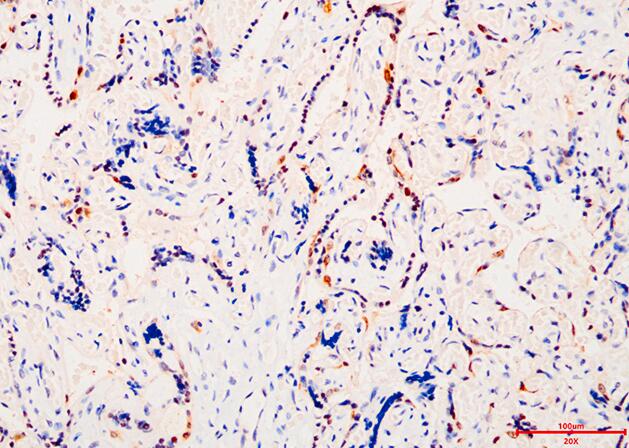Human PlGF Antibody Summary
Ala21-Arg149
Accession # P49763
Applications
Human PlGF Sandwich Immunoassay
Please Note: Optimal dilutions should be determined by each laboratory for each application. General Protocols are available in the Technical Information section on our website.
Scientific Data
 View Larger
View Larger
Detection of Human PLGF by Block/Neutralize Anti-PlGF neutralising antibody blocks DMOG-induced inhibition of ECFC tube formation. ECFCs were stained with calcein (Invitrogen) and grown on Matrigel®. Cells were treated with conditioned medium harvested from ECFCs treated with a DMSO (vehicle) plus isotype control IgG, b DMOG plus isotype control IgG, c DMSO plus anti-PlGF neutralising antibody or d DMOG plus anti-PlGF neutralising antibody. e At 48 h, total tube area (μm2) was quantified using NIS Elements software (Nikon). Data plotted as mean ± SD and are representative of three independent experiments. **p < 0.01; ***p < 0.001. Scale bars: 200 μm (n = 3). DMOG dimethyloxalylglycine, PlGF placental growth factor Image collected and cropped by CiteAb from the following publication (https://pubmed.ncbi.nlm.nih.gov/27899144), licensed under a CC-BY license. Not internally tested by R&D Systems.
 View Larger
View Larger
Detection of Human PLGF by Block/Neutralize Anti-PlGF neutralising antibody blocks DMOG-induced inhibition of ECFC tube formation. ECFCs were stained with calcein (Invitrogen) and grown on Matrigel®. Cells were treated with conditioned medium harvested from ECFCs treated with a DMSO (vehicle) plus isotype control IgG, b DMOG plus isotype control IgG, c DMSO plus anti-PlGF neutralising antibody or d DMOG plus anti-PlGF neutralising antibody. e At 48 h, total tube area (μm2) was quantified using NIS Elements software (Nikon). Data plotted as mean ± SD and are representative of three independent experiments. **p < 0.01; ***p < 0.001. Scale bars: 200 μm (n = 3). DMOG dimethyloxalylglycine, PlGF placental growth factor Image collected and cropped by CiteAb from the following publication (https://pubmed.ncbi.nlm.nih.gov/27899144), licensed under a CC-BY license. Not internally tested by R&D Systems.
Preparation and Storage
- 12 months from date of receipt, -20 to -70 °C as supplied.
- 1 month, 2 to 8 °C under sterile conditions after reconstitution.
- 6 months, -20 to -70 °C under sterile conditions after reconstitution.
Background: PlGF
Placenta growth factor (PlGF) is a member of the vascular endothelial growth factor (VEGF) family of growth factors. As a result of alternative splicing, at least two PlGF mRNAs encoding monomeric PlGF precursors containing 149 and 170 amino acid residues have been described. The expression of PlGF is not widespread but has been detected in human umbilical vein endothelial cells, placenta, choriocarcinoma cell lines, and in renal cell carcinoma associated with angiogenesis. The PlGF proteins bind with high-affinity to VEGF R1/Flt-1 but not to VEGF R2/Flk-1.
Product Datasheets
Citations for Human PlGF Antibody
R&D Systems personnel manually curate a database that contains references using R&D Systems products. The data collected includes not only links to publications in PubMed, but also provides information about sample types, species, and experimental conditions.
5
Citations: Showing 1 - 5
Filter your results:
Filter by:
-
Placenta growth factor and neuropilin-1 collaborate in promoting melanoma aggressiveness
Authors: ELENA PAGANI, FEDERICA RUFFINI, GIAN CARLO ANTONINI Antonini Cappellini, ALESSANDRO SCOPPOLA, CRISTINA FORTES, PAOLO MARCHETTI et al.
International Journal of Oncology
-
Hypoxia-induced responses by endothelial colony-forming cells are modulated by placental growth factor
Stem Cell Res Ther, 2016-11-29;7(1):173.
Species: Human
Sample Types: Whole Cells
Applications: Neutralization -
Interaction of mesenchymal stem cells with fibroblast-like synoviocytes via cadherin-11 promotes angiogenesis by enhanced secretion of placental growth factor.
Authors: Park, Su-Jung, Kim, Ki-Jo, Kim, Wan-Uk, Cho, Chul-Soo
J Immunol, 2014-02-26;192(7):3003-10.
Species: Mouse
Sample Types: Matrigel Plug
Applications: Neutralization -
Der p, IL-4, and TGF-beta cooperatively induce EGFR-dependent TARC expression in airway epithelium.
Authors: Heijink IH, Marcel Kies P, van Oosterhout AJ, Postma DS, Kauffman HF, Vellenga E
Am. J. Respir. Cell Mol. Biol., 2006-10-05;36(3):351-9.
Species: Human
Sample Types: Whole Cells
Applications: Neutralization -
Placenta growth factor in diabetic wound healing: altered expression and therapeutic potential.
Authors: Cianfarani F, Zambruno G, Brogelli L, Sera F, Lacal PM, Pesce M, Capogrossi MC, Failla CM, Napolitano M, Odorisio T
Am. J. Pathol., 2006-10-01;169(4):1167-82.
Species: Human
Sample Types: Whole Cells
Applications: Neutralization
FAQs
No product specific FAQs exist for this product, however you may
View all Antibody FAQsReviews for Human PlGF Antibody
Average Rating: 5 (Based on 2 Reviews)
Have you used Human PlGF Antibody?
Submit a review and receive an Amazon gift card.
$25/€18/£15/$25CAN/¥75 Yuan/¥2500 Yen for a review with an image
$10/€7/£6/$10 CAD/¥70 Yuan/¥1110 Yen for a review without an image
Filter by:
Cells were fixed in 4% paraformaldehyde for 20 min
at room temperature. Following PBS washes, cells were
permeabilised with 0.1% Triton X-100 for 10 min at RT
and then blocked in 1% bovine serum albumin for
2 h in PBS before overnight incubation in primary antibody
at 4 °C. After washing with PBS, cells were incubated
with appropriate secondary antibody for 1 h at RT and
imaged
Human placenta were fixed in 4% paraformaldehyde. Tissue was embedded and 5 micron sections cut. Sections were permeabilized with PBS containing 0.1% Triton X-100, then blocked for 30 min in 3% BSA in PBS containing 0.1% Triton X-100. Goat Anti-Human PIGF Antigen was diluted in blocking buffer to 1:200 and applied to sections for 1 hour at RT. Sections were washed 3X with PBS containing 0.1% Triton X-100, then incubated with secondary antibody.


